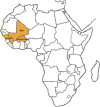Seasonal Malaria Chemoprevention Implementation: Effect on Malaria Incidence and Immunity in a Context of Expansion of P. falciparum Resistant Genotypes with Potential Reduction of the Effectiveness in Sub-Saharan Africa
- PMID: 35992756
- PMCID: PMC9386169
- DOI: 10.2147/IDR.S375197
Seasonal Malaria Chemoprevention Implementation: Effect on Malaria Incidence and Immunity in a Context of Expansion of P. falciparum Resistant Genotypes with Potential Reduction of the Effectiveness in Sub-Saharan Africa
Abstract
Seasonal Malaria Chemoprevention (SMC), which combines amodiaquine (AQ) with sulfadoxine-pyrimethamine (SP), is an effective and promising strategy, recommended by WHO, for controlling malaria morbidity and mortality in areas of intense seasonal transmission. Despite the effectiveness of this strategy, a number of controversies regarding the impact of the development of malaria-specific immunity and challenges of the strategy in the context of increasing and expanding antimalarial drugs resistance but also the limited coverage of the SMC in children make the relevance of the SMC questionable, especially in view of the financial and logistical investments. Indeed, the number of malaria cases in the target group, children under 5 years old, has increased while the implementation of SMC is been extended in several African countries. This ambivalence of the SMC strategy, the increase in the prevalence of malaria cases suggests the need to evaluate the SMC and understand some of the factors that may hinder the success of this strategy in the implementation areas. The present review discusses the impact of the SMC on malaria morbidity, parasite resistance to antimalarial drugs, molecular and the immunity affecting the incidence of malaria in children. This approach will contribute to improving the malaria control strategy in highly seasonal transmission areas where the SMC is implemented.
Keywords: amodiaquine; immunity; resistance; seasonal malaria chemoprevention; sulfadoxine-pyrimethamine.
© 2022 Nikiema et al.
Conflict of interest statement
The authors declare that they have no competing interests.
Figures



References
-
- World Health Organization. World Malaria Report; 2021. ISBN978 92 4 004049 6.
-
- Ndiaye M, Sylla K, Sow D, et al. Potential impact of seasonal malaria chemoprevention on the acquisition of antibodies against glutamate-rich protein and apical membrane antigen 1 in children living in Southern Senegal. Am J Trop Med Hyg. 2015;93(4):798–800. doi:10.4269/ajtmh.14-0808 - DOI - PMC - PubMed
-
- World Health Organization. Seasonal Malaria Chemoprevention (SMC) for Plasmodium Falciparum Malaria Control in Highly Seasonal Transmission Areas of the Sahel Sub-Regions in Africa. Geneva, Switzerland: WHO Global Malaria Programme; 2012.
Publication types
LinkOut - more resources
Full Text Sources

